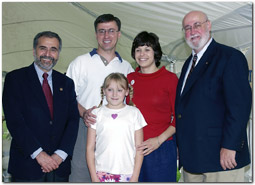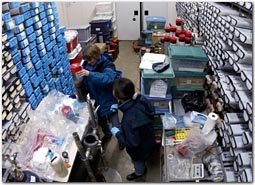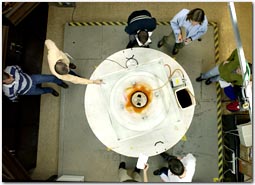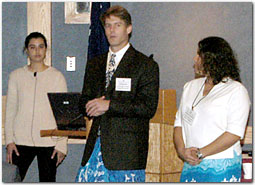|
|
 |
Academic Programs > Report from the Vice President for Academic Programs and Dean
Report from the Vice President for Academic Programs and Dean
 |
 |
|
At the 2002 MIT/WHOI Joint Program graduate reception in June, degree recipient Ben Reeder is joined by his daughter Emma and wife Lisa, and flanked by WHOI President and Director Bob Gagosian, left, and John Farrington, Vice President for Academic Programs and Dean. Dr. Reeder completed a PhD degree in ocean engineering and serves as a lieutenant commander in the US Navy aboard USS Tarawa. (Photo by Tom Kleindinst)
|
Institution educational activities focus on close interaction with research, where learning takes place in small groups and one-on-one. This engages bright, early career scientists in a dynamic ocean research environment. Our alumni/ae are leaders in the academic, government, industry, and nonprofit sectors of ocean science, policy, engineering, and education. Our present postdocs and students are on course for continuing this legacy.
Our postdoctoral program has expanded over the past several years. Fifty to eighty-two postdoctoral appointees are present each year, about half funded by WHOI fellowships or research projects and about half with fellowship support from their home countries. Four new fellowships for interdisciplinary studies were added in 2002 by the WHOI Ocean Institutes.
 |
 |
|
MIT/WHOI Joint Program graduate students Linda Kalnejais, left, and Tracy Quan section a core in the WHOI core lab. (Photo by Tom Kleindinst)
|
Mario Sengco was chosen by the graduate students to receive the first Panteleyev Award. This award, honoring the memory of George P. “Gera” Panteleyev, a Joint Program student who lost his life in Siberia while pursuing graduate research, was presented at the WHOI graduation celebration. The annual award is given to the graduating student who exemplifies a commitment to improving the graduate educational experience and student life at WHOI.
For the 2002 Joint Program, 167 students applied, 40 were admitted, and 24 matriculated, bringing enrollment to 121. Fifteen PhD and six SM degrees were granted. Our graduate students are encouraged to learn from each other in addition to formal and informal learning with the faculty and staff. Exemplifying this tradition, graduate students Margaret Boettcher and Jeff Standish assisted their colleague Rhea Workman in her fieldwork in American Samoa-as did her thesis advisor Stan Hart, Senior Scientist in the Geology and Geophysics Department. Rhea’s thesis focuses on the Samoan Islands volcanoes and contributes to the overall understanding of ocean basin dynamics. All three students shared their field experiences with WHOI Corporation Members, Trustees and guests in a presentation at the May 2002 Annual WHOI Meeting (opposite, top right).
 |
 |
|
In the Rinehart Coastal Research Center, students study fluid mixing properties at a rotating table used for geophysical fluid dynamics experiments. (Photo by Tom Kleindinst) |
The 2002 Summer Student Fellowship and Minority Fellowship Program for undergraduates included 26 participants from 15 US and five international colleges and universities. Research by Nicholas Hartmann from Pennsylvania State University, for example, furthers knowledge of the cycling of colored material in the surface oceans, which has far-reaching consequences for understanding remote sensing of the oceans and chemical reactions at the ocean surface. Nick’s research, conducted under the guidance of Dan Repeta, Senior Scientist in the Marine Chemistry and Geochemistry Department, was selected for presentation in the Research Experiences for Undergraduates at the American Society of Limnology and Oceanography meeting in February 2003. Nick has been selected for a prestigious, nationally competitive George C. Marshall Fellowship to study during the 2003-2004 academic year at the University of Cambridge, UK.
 |
 |
|
Joint Program students, from left, Rhea Workman, Jeff Standish, and Margaret Boettcher report to Corporators and guests on their field research in Samoa on ocean volcanic islands. (Photo by Tom Kleindinst)
|
For several decades, Woods Hole Oceanographic Institution has engaged in formal and informal K-12 education activities. This year, WHOI, in association with the New England Aquarium and the University of Massachusetts system, received funding from the National Science Foundation to establish a New England Regional Center for Ocean Science Education Excellence (COSEE). This is part of an NSF-funded national network of such centers responsible for facilitating collaboration and communication between ocean science researchers and educators. The principal investigator at WHOI is Deborah Smith, Senior Scientist in the Geology and Geophysics Department. Working closely with Debbie in NER-COSEE efforts at WHOI are Andrea Thorrold, NER-COSEE WHOI coordinator, Tracey Crago, Kate Madin, and Stephanie Murphy.
—John W. Farrington, Vice President for Academic Programs and Dean
|
|
 |
|
